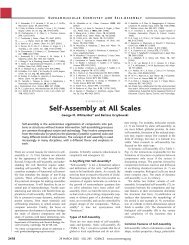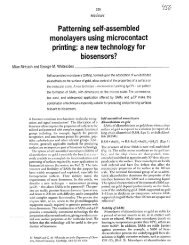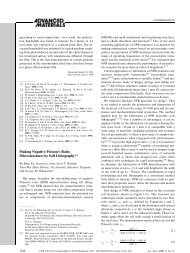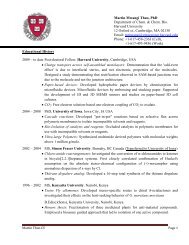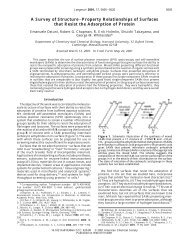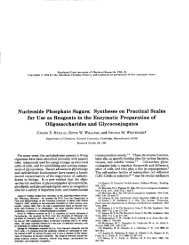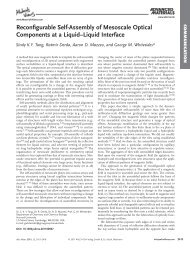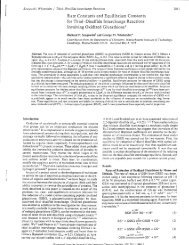Self-Assembled Monolayers of Thiolates on Metals as - Whitesides ...
Self-Assembled Monolayers of Thiolates on Metals as - Whitesides ...
Self-Assembled Monolayers of Thiolates on Metals as - Whitesides ...
Create successful ePaper yourself
Turn your PDF publications into a flip-book with our unique Google optimized e-Paper software.
1146 Chemical Reviews, 2005, Vol. 105, No. 4 Love et al.<br />
complex and dynamic behaviors. 14 They c<strong>on</strong>sist <str<strong>on</strong>g>of</str<strong>on</strong>g><br />
supermolecular <strong>as</strong>semblies <str<strong>on</strong>g>of</str<strong>on</strong>g> proteins, glycoproteins,<br />
and large oligosaccharides anchored to or embedded<br />
in a fluid lipid bilayer or protein coat. The <strong>as</strong>semblies<br />
can have dimensi<strong>on</strong>s ranging from a few to hundreds<br />
<str<strong>on</strong>g>of</str<strong>on</strong>g> nanometers; for example, integrins are cylindrical<br />
transmembrane proteins (8-12 nm in diameter) that<br />
<strong>as</strong>semble into small clusters when cells attach to<br />
extracellular matrixes <str<strong>on</strong>g>of</str<strong>on</strong>g> protein. 648<br />
The broad range <str<strong>on</strong>g>of</str<strong>on</strong>g> membrane-bound <strong>as</strong>semblies<br />
present in biological membranes c<strong>on</strong>trol many processes<br />
in living organisms (from bacteria to complex,<br />
multicellular organisms). The interacti<strong>on</strong>s between<br />
single ligand-receptor pairs (or <str<strong>on</strong>g>of</str<strong>on</strong>g>ten groups or<br />
clusters <str<strong>on</strong>g>of</str<strong>on</strong>g> molecules) 425 enable the cell to sense its<br />
envir<strong>on</strong>ment, communicate with other cells, and<br />
regulate intracellular functi<strong>on</strong>s such <strong>as</strong> migrati<strong>on</strong>,<br />
adhesi<strong>on</strong>, growth, divisi<strong>on</strong>, differentiati<strong>on</strong>, and<br />
apoptosis.<br />
The compositi<strong>on</strong>al complexity and dynamic nature<br />
<str<strong>on</strong>g>of</str<strong>on</strong>g> biological surfaces make it difficult to study certain<br />
fundamental <strong>as</strong>pects <str<strong>on</strong>g>of</str<strong>on</strong>g> biological systems in detail.<br />
Model surfaces with well-defined compositi<strong>on</strong>s provide<br />
useful tools for studying the physical-organic<br />
chemistry <str<strong>on</strong>g>of</str<strong>on</strong>g> biomolecular recogniti<strong>on</strong> (for example,<br />
the thermodynamics and kinetics <str<strong>on</strong>g>of</str<strong>on</strong>g> the <strong>as</strong>sociati<strong>on</strong>/<br />
dissociati<strong>on</strong> <str<strong>on</strong>g>of</str<strong>on</strong>g> proteins or other biomolecules with<br />
ligands) for determining the effect <str<strong>on</strong>g>of</str<strong>on</strong>g> individual<br />
recogniti<strong>on</strong> events <strong>on</strong> the functi<strong>on</strong>al behavior <str<strong>on</strong>g>of</str<strong>on</strong>g> cells<br />
and investigating the structural factors that enable<br />
surfaces to resist the adsorpti<strong>on</strong> <str<strong>on</strong>g>of</str<strong>on</strong>g> proteins. The<br />
development <str<strong>on</strong>g>of</str<strong>on</strong>g> biotechnological applicati<strong>on</strong>s, such <strong>as</strong><br />
cell culture, tissue engineering, and biosensors, 649<br />
also can benefit from simplified systems that allow<br />
<strong>on</strong>ly <strong>on</strong>e or a few types <str<strong>on</strong>g>of</str<strong>on</strong>g> interacti<strong>on</strong>s between<br />
species in soluti<strong>on</strong> (cells, biomolecules, analytes) and<br />
the surfaces <str<strong>on</strong>g>of</str<strong>on</strong>g> the engineered system. One primary<br />
challenge in developing model surfaces ex vivo is<br />
developing methods that allow precise c<strong>on</strong>trol <str<strong>on</strong>g>of</str<strong>on</strong>g> the<br />
compositi<strong>on</strong> and structure <str<strong>on</strong>g>of</str<strong>on</strong>g> the surface while permitting<br />
natural biological interacti<strong>on</strong>s to occur in<br />
such a way that the results can be interpreted clearly<br />
and related to biology in vivo.<br />
SAMs are useful <strong>as</strong> model surfaces for studying<br />
biological and biochemical processes. First, like the<br />
biological surfaces they mimic, they are nanostructured<br />
materials that form by self-<strong>as</strong>sembly.<br />
Sec<strong>on</strong>d, they can present a wide range <str<strong>on</strong>g>of</str<strong>on</strong>g> organic<br />
functi<strong>on</strong>ality rati<strong>on</strong>ally, including functi<strong>on</strong>ality that<br />
can resist the adsorpti<strong>on</strong> <str<strong>on</strong>g>of</str<strong>on</strong>g> proteins, at positi<strong>on</strong>s<br />
away from the plane <str<strong>on</strong>g>of</str<strong>on</strong>g> the substrate with nearly<br />
atomic-level precisi<strong>on</strong>. Third, it is e<strong>as</strong>y to prepare<br />
SAMs functi<strong>on</strong>alized with the large, delicate ligands<br />
needed for biological studies by either synthesizing<br />
molecules with the ligand attached to form the SAM<br />
or, more comm<strong>on</strong>ly, attaching the ligands to the<br />
surface <str<strong>on</strong>g>of</str<strong>on</strong>g> a preformed, reactive SAM (see secti<strong>on</strong> 5).<br />
Fourth, SAMs are directly compatible with a number<br />
<str<strong>on</strong>g>of</str<strong>on</strong>g> techniques (surface pl<strong>as</strong>m<strong>on</strong> res<strong>on</strong>ance (SPR)<br />
spectroscopy, 650,651 optical ellipsometry, 408,409 RAI-<br />
RS, 409 QCM, 652 m<strong>as</strong>s spectroscopy 653 ) for analyzing<br />
the compositi<strong>on</strong> and m<strong>as</strong>s coverage <str<strong>on</strong>g>of</str<strong>on</strong>g> surfaces <strong>as</strong> well<br />
<strong>as</strong> the thermodynamics and kinetics <str<strong>on</strong>g>of</str<strong>on</strong>g> binding<br />
events. Fifth, SAMs are less influenced by effects <str<strong>on</strong>g>of</str<strong>on</strong>g><br />
m<strong>as</strong>s transport than the thick gel layers sometimes<br />
used to immobilize ligands <strong>on</strong> surfaces for SPR.<br />
One disadvantage <str<strong>on</strong>g>of</str<strong>on</strong>g> SAMs <strong>as</strong> model surfaces is<br />
that the structure <str<strong>on</strong>g>of</str<strong>on</strong>g> the SAM is essentially static.<br />
This characteristic differs from that <str<strong>on</strong>g>of</str<strong>on</strong>g> biological<br />
membranes, which are fluid and rearrange dynamically.<br />
Langmuir-Blodgett (LB) films 654 and rec<strong>on</strong>stituted<br />
bilayers <str<strong>on</strong>g>of</str<strong>on</strong>g> lipids <strong>on</strong> solid supports 655 present<br />
two alternative technologies for creating dynamic<br />
models <str<strong>on</strong>g>of</str<strong>on</strong>g> biological surfaces. The utility <str<strong>on</strong>g>of</str<strong>on</strong>g> LB films<br />
in this area <str<strong>on</strong>g>of</str<strong>on</strong>g> study remains limited due to instrumental<br />
complexity and difficulties with reproducibility;<br />
LB films (at the air-water interface) do,<br />
however, generate systems in which in-plane diffusi<strong>on</strong><br />
and transmembrane experiments are possible.<br />
Advances in techniques for patterning regi<strong>on</strong>s <str<strong>on</strong>g>of</str<strong>on</strong>g> lipid<br />
bilayers <strong>on</strong> solid supports and defining their compositi<strong>on</strong>s<br />
also are beginning to emerge and could <str<strong>on</strong>g>of</str<strong>on</strong>g>fer<br />
an important complementary tool for generating<br />
model biological systems. 656<br />
8.4.1. Designing SAMs To Be Model Biological Surfaces<br />
To test a range <str<strong>on</strong>g>of</str<strong>on</strong>g> experimental c<strong>on</strong>diti<strong>on</strong>s and<br />
facilitate the interpretati<strong>on</strong> <str<strong>on</strong>g>of</str<strong>on</strong>g> the interacti<strong>on</strong>s observed,<br />
SAMs should have, at a minimum, three<br />
characteristics: (1) they should be able to prevent<br />
n<strong>on</strong>specific adsorpti<strong>on</strong> <str<strong>on</strong>g>of</str<strong>on</strong>g> proteins or other biomolecules<br />
<strong>on</strong> the surface, that is, they should <strong>on</strong>ly allow<br />
interacti<strong>on</strong>s between the molecules and ligands <str<strong>on</strong>g>of</str<strong>on</strong>g><br />
interest and thus permit meaningful analysis <str<strong>on</strong>g>of</str<strong>on</strong>g><br />
observati<strong>on</strong>s made to determine the sensitivity or<br />
kinetics <str<strong>on</strong>g>of</str<strong>on</strong>g> these processes; (2) they should allow<br />
modificati<strong>on</strong>s to the compositi<strong>on</strong> and density <str<strong>on</strong>g>of</str<strong>on</strong>g> the<br />
immobilized ligands or biomolecules (proteins, sugars,<br />
antigens); and (3) they should present the ligands<br />
<str<strong>on</strong>g>of</str<strong>on</strong>g> interest in a structurally well-defined manner that<br />
minimizes the influences <str<strong>on</strong>g>of</str<strong>on</strong>g> the surface, e.g., limited<br />
m<strong>as</strong>s transport, blocked binding sites, or induced<br />
c<strong>on</strong>formati<strong>on</strong>al changes. It is also helpful if the model<br />
surfaces can be used e<strong>as</strong>ily with comm<strong>on</strong> analytical<br />
methods without modifying the existing instrumentati<strong>on</strong><br />
or without subjecting the samples to unnatural<br />
(for biology) c<strong>on</strong>diti<strong>on</strong>s, e.g., in dehydrated form in<br />
UHV.<br />
Protein-Resistant Surfaces. Surfaces that resist<br />
the n<strong>on</strong>specific adsorpti<strong>on</strong> <str<strong>on</strong>g>of</str<strong>on</strong>g> other biomolecules and<br />
cells comm<strong>on</strong>ly are called “inert” surfaces. The best<br />
protein-resistant surfaces presently known are <strong>on</strong>es<br />
composed <str<strong>on</strong>g>of</str<strong>on</strong>g> oligo- or poly(ethylene glycol) (OEG or<br />
PEG). 657 Alkanethiols terminated with tri- or hexa-<br />
(ethylene glycol) groups are a standard comp<strong>on</strong>ent<br />
<str<strong>on</strong>g>of</str<strong>on</strong>g> SAMs used to study biology and biochemistry. 658,659<br />
On gold the alkane chains form a dense, ordered<br />
m<strong>on</strong>olayer with the same molecular c<strong>on</strong>formati<strong>on</strong><br />
found for n-alkanethiols, i.e., all-trans chains with a<br />
30° tilt; the terminal ethylene glycol end-group<br />
adopts either a helical c<strong>on</strong>formati<strong>on</strong> aligned perpendicular<br />
to the surface or an amorphous c<strong>on</strong>formati<strong>on</strong>.<br />
660,661 The helical structures yield a qu<strong>as</strong>icrystalline<br />
surface ph<strong>as</strong>e, but the amorphous chains<br />
produce a liquidlike ph<strong>as</strong>e. NEXAFS me<strong>as</strong>urements<br />
indicate that both c<strong>on</strong>formati<strong>on</strong>s exist <strong>on</strong> the surface<br />
simultaneously in a vacuum. 662 There is also evidence<br />
that these end groups can undergo order-order




